Analysis of Wind Energy Subsidies in International Trade (HI5016)
VerifiedAdded on 2023/01/23
|21
|5189
|72
Report
AI Summary
This report analyzes the impact of international trade and subsidies on the wind energy industry, focusing on countries like Australia, China, and India. It examines the importance of wind energy, positive and negative effects of subsidies, and the role of government policies. The study explores the impact of GDP on the wind energy sector, analyzes the terms of trade, and identifies the comparative advantages of companies in this industry. The report also highlights the significance of renewable energy sources, the increasing demand for wind energy, and the economic implications of subsidies, including their influence on investment, resource distribution, and the consumption of energy. The report also analyzes the economic growth of the mentioned countries and the impact of wind energy on their economies.
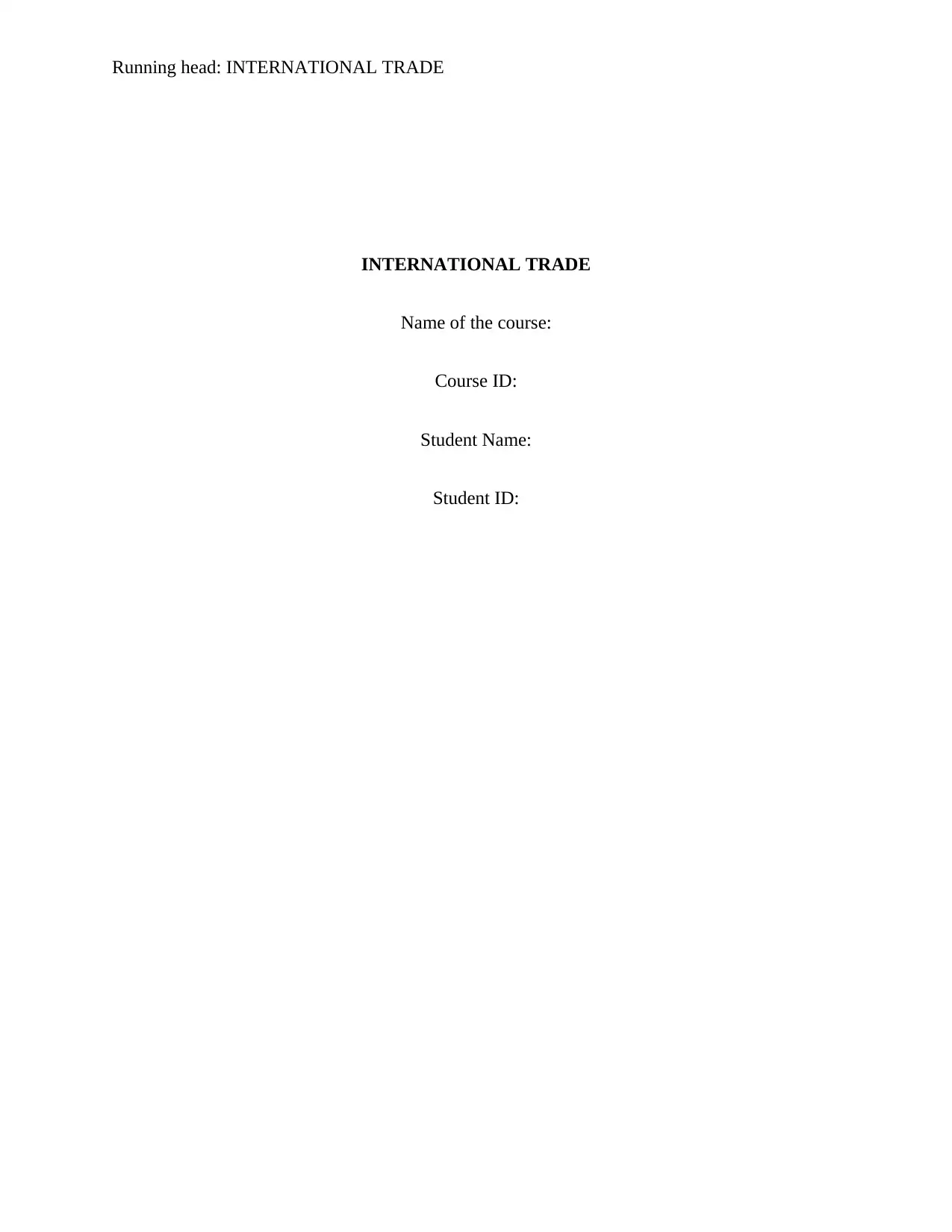
Running head: INTERNATIONAL TRADE
INTERNATIONAL TRADE
Name of the course:
Course ID:
Student Name:
Student ID:
INTERNATIONAL TRADE
Name of the course:
Course ID:
Student Name:
Student ID:
Paraphrase This Document
Need a fresh take? Get an instant paraphrase of this document with our AI Paraphraser
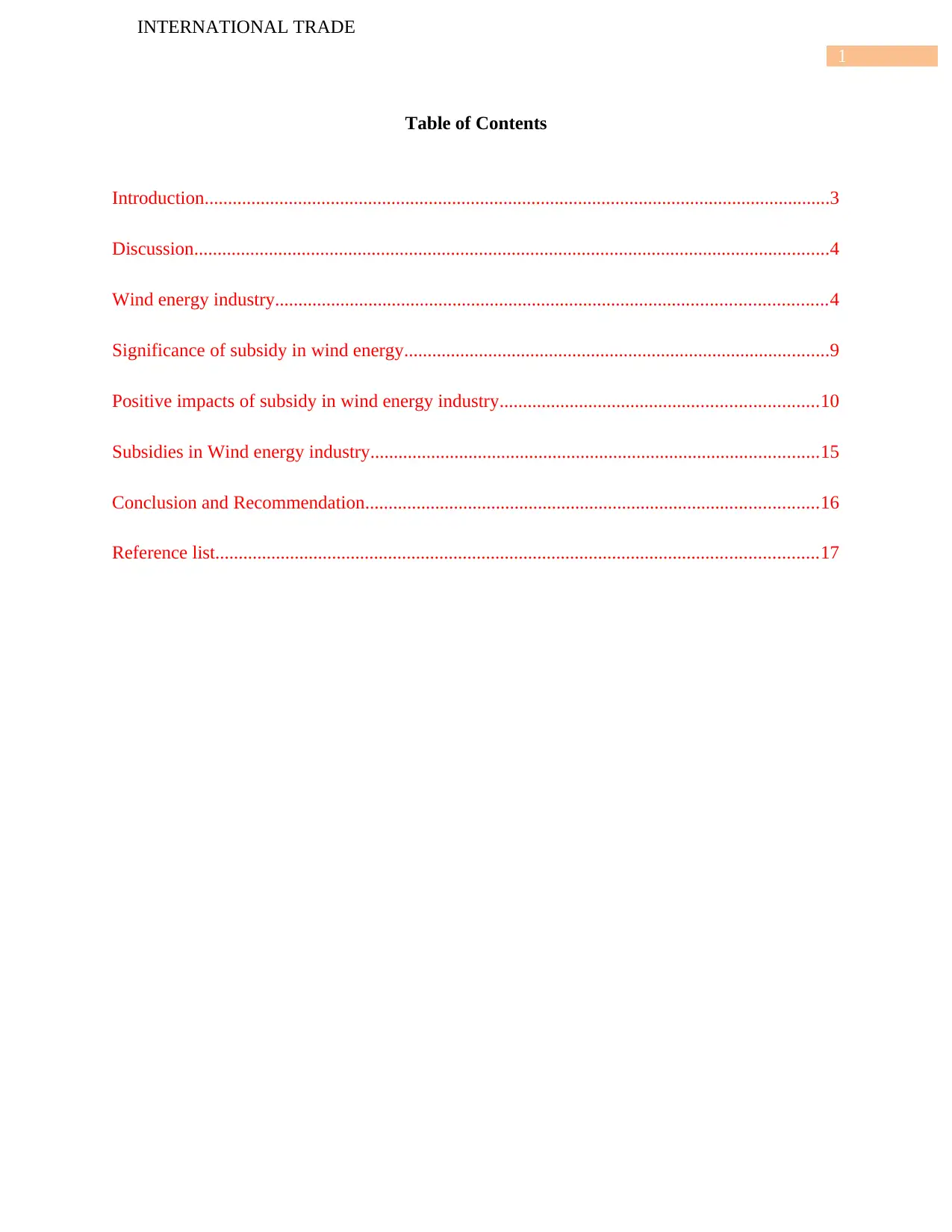
1
INTERNATIONAL TRADE
Table of Contents
Introduction......................................................................................................................................3
Discussion........................................................................................................................................4
Wind energy industry......................................................................................................................4
Significance of subsidy in wind energy...........................................................................................9
Positive impacts of subsidy in wind energy industry....................................................................10
Subsidies in Wind energy industry................................................................................................15
Conclusion and Recommendation.................................................................................................16
Reference list.................................................................................................................................17
INTERNATIONAL TRADE
Table of Contents
Introduction......................................................................................................................................3
Discussion........................................................................................................................................4
Wind energy industry......................................................................................................................4
Significance of subsidy in wind energy...........................................................................................9
Positive impacts of subsidy in wind energy industry....................................................................10
Subsidies in Wind energy industry................................................................................................15
Conclusion and Recommendation.................................................................................................16
Reference list.................................................................................................................................17
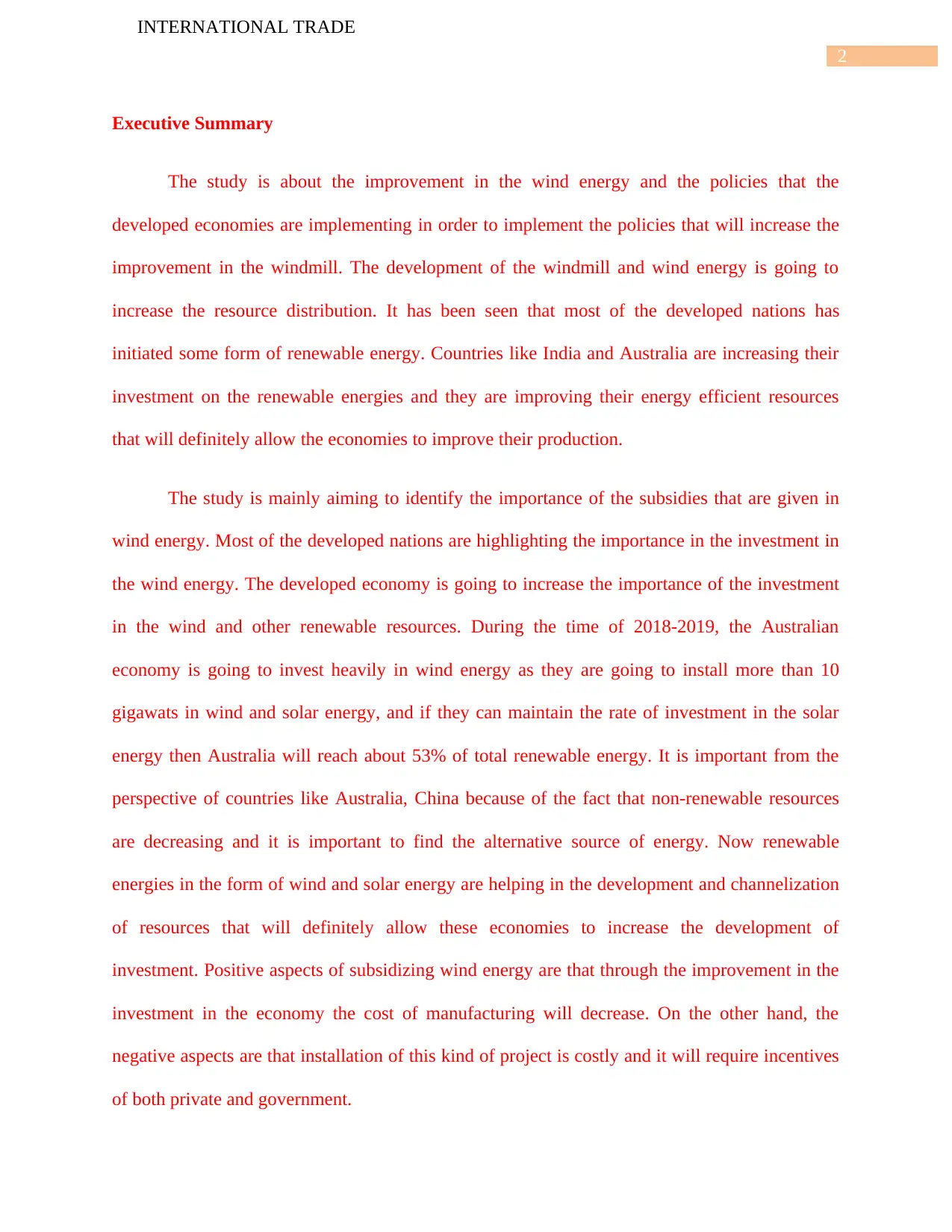
2
INTERNATIONAL TRADE
Executive Summary
The study is about the improvement in the wind energy and the policies that the
developed economies are implementing in order to implement the policies that will increase the
improvement in the windmill. The development of the windmill and wind energy is going to
increase the resource distribution. It has been seen that most of the developed nations has
initiated some form of renewable energy. Countries like India and Australia are increasing their
investment on the renewable energies and they are improving their energy efficient resources
that will definitely allow the economies to improve their production.
The study is mainly aiming to identify the importance of the subsidies that are given in
wind energy. Most of the developed nations are highlighting the importance in the investment in
the wind energy. The developed economy is going to increase the importance of the investment
in the wind and other renewable resources. During the time of 2018-2019, the Australian
economy is going to invest heavily in wind energy as they are going to install more than 10
gigawats in wind and solar energy, and if they can maintain the rate of investment in the solar
energy then Australia will reach about 53% of total renewable energy. It is important from the
perspective of countries like Australia, China because of the fact that non-renewable resources
are decreasing and it is important to find the alternative source of energy. Now renewable
energies in the form of wind and solar energy are helping in the development and channelization
of resources that will definitely allow these economies to increase the development of
investment. Positive aspects of subsidizing wind energy are that through the improvement in the
investment in the economy the cost of manufacturing will decrease. On the other hand, the
negative aspects are that installation of this kind of project is costly and it will require incentives
of both private and government.
INTERNATIONAL TRADE
Executive Summary
The study is about the improvement in the wind energy and the policies that the
developed economies are implementing in order to implement the policies that will increase the
improvement in the windmill. The development of the windmill and wind energy is going to
increase the resource distribution. It has been seen that most of the developed nations has
initiated some form of renewable energy. Countries like India and Australia are increasing their
investment on the renewable energies and they are improving their energy efficient resources
that will definitely allow the economies to improve their production.
The study is mainly aiming to identify the importance of the subsidies that are given in
wind energy. Most of the developed nations are highlighting the importance in the investment in
the wind energy. The developed economy is going to increase the importance of the investment
in the wind and other renewable resources. During the time of 2018-2019, the Australian
economy is going to invest heavily in wind energy as they are going to install more than 10
gigawats in wind and solar energy, and if they can maintain the rate of investment in the solar
energy then Australia will reach about 53% of total renewable energy. It is important from the
perspective of countries like Australia, China because of the fact that non-renewable resources
are decreasing and it is important to find the alternative source of energy. Now renewable
energies in the form of wind and solar energy are helping in the development and channelization
of resources that will definitely allow these economies to increase the development of
investment. Positive aspects of subsidizing wind energy are that through the improvement in the
investment in the economy the cost of manufacturing will decrease. On the other hand, the
negative aspects are that installation of this kind of project is costly and it will require incentives
of both private and government.
⊘ This is a preview!⊘
Do you want full access?
Subscribe today to unlock all pages.

Trusted by 1+ million students worldwide
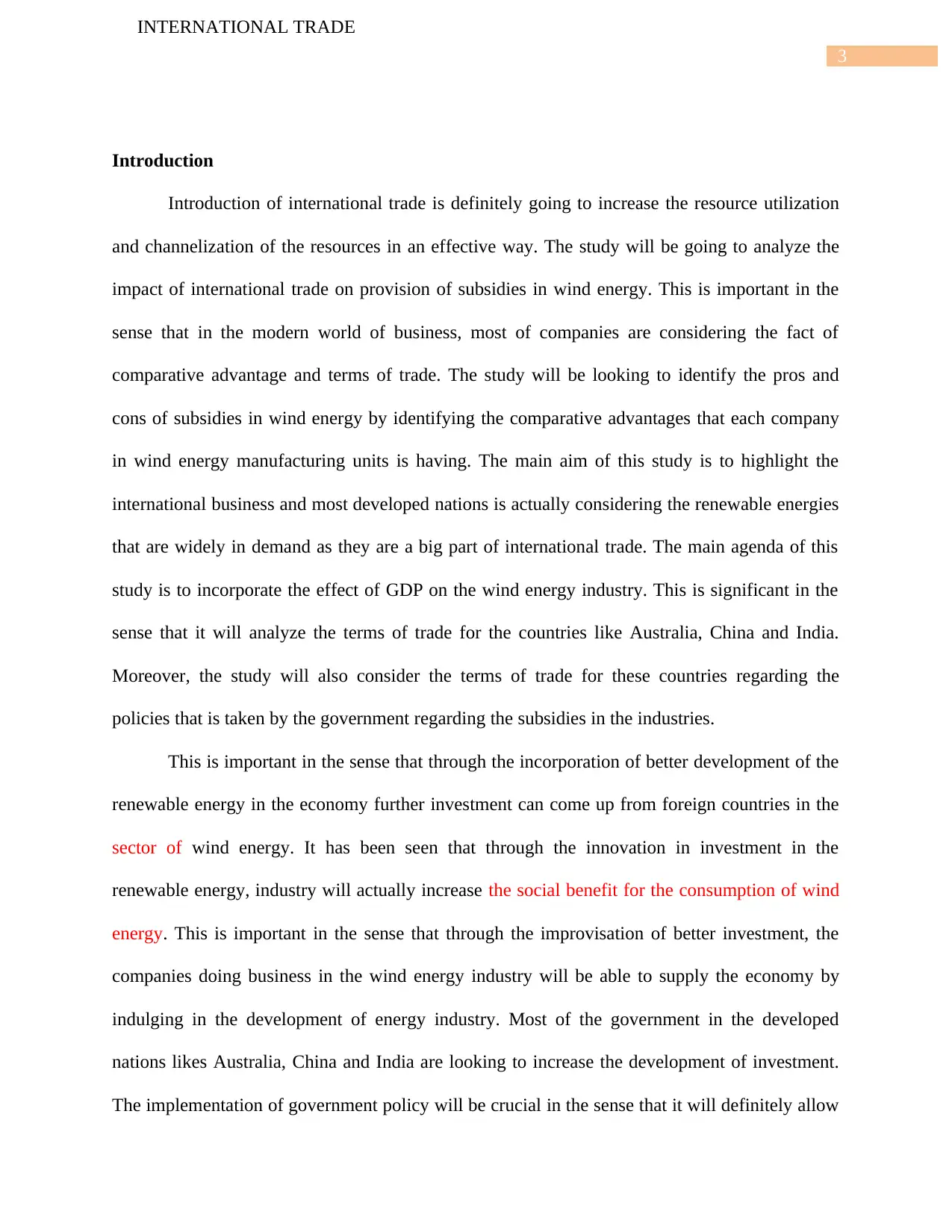
3
INTERNATIONAL TRADE
Introduction
Introduction of international trade is definitely going to increase the resource utilization
and channelization of the resources in an effective way. The study will be going to analyze the
impact of international trade on provision of subsidies in wind energy. This is important in the
sense that in the modern world of business, most of companies are considering the fact of
comparative advantage and terms of trade. The study will be looking to identify the pros and
cons of subsidies in wind energy by identifying the comparative advantages that each company
in wind energy manufacturing units is having. The main aim of this study is to highlight the
international business and most developed nations is actually considering the renewable energies
that are widely in demand as they are a big part of international trade. The main agenda of this
study is to incorporate the effect of GDP on the wind energy industry. This is significant in the
sense that it will analyze the terms of trade for the countries like Australia, China and India.
Moreover, the study will also consider the terms of trade for these countries regarding the
policies that is taken by the government regarding the subsidies in the industries.
This is important in the sense that through the incorporation of better development of the
renewable energy in the economy further investment can come up from foreign countries in the
sector of wind energy. It has been seen that through the innovation in investment in the
renewable energy, industry will actually increase the social benefit for the consumption of wind
energy. This is important in the sense that through the improvisation of better investment, the
companies doing business in the wind energy industry will be able to supply the economy by
indulging in the development of energy industry. Most of the government in the developed
nations likes Australia, China and India are looking to increase the development of investment.
The implementation of government policy will be crucial in the sense that it will definitely allow
INTERNATIONAL TRADE
Introduction
Introduction of international trade is definitely going to increase the resource utilization
and channelization of the resources in an effective way. The study will be going to analyze the
impact of international trade on provision of subsidies in wind energy. This is important in the
sense that in the modern world of business, most of companies are considering the fact of
comparative advantage and terms of trade. The study will be looking to identify the pros and
cons of subsidies in wind energy by identifying the comparative advantages that each company
in wind energy manufacturing units is having. The main aim of this study is to highlight the
international business and most developed nations is actually considering the renewable energies
that are widely in demand as they are a big part of international trade. The main agenda of this
study is to incorporate the effect of GDP on the wind energy industry. This is significant in the
sense that it will analyze the terms of trade for the countries like Australia, China and India.
Moreover, the study will also consider the terms of trade for these countries regarding the
policies that is taken by the government regarding the subsidies in the industries.
This is important in the sense that through the incorporation of better development of the
renewable energy in the economy further investment can come up from foreign countries in the
sector of wind energy. It has been seen that through the innovation in investment in the
renewable energy, industry will actually increase the social benefit for the consumption of wind
energy. This is important in the sense that through the improvisation of better investment, the
companies doing business in the wind energy industry will be able to supply the economy by
indulging in the development of energy industry. Most of the government in the developed
nations likes Australia, China and India are looking to increase the development of investment.
The implementation of government policy will be crucial in the sense that it will definitely allow
Paraphrase This Document
Need a fresh take? Get an instant paraphrase of this document with our AI Paraphraser
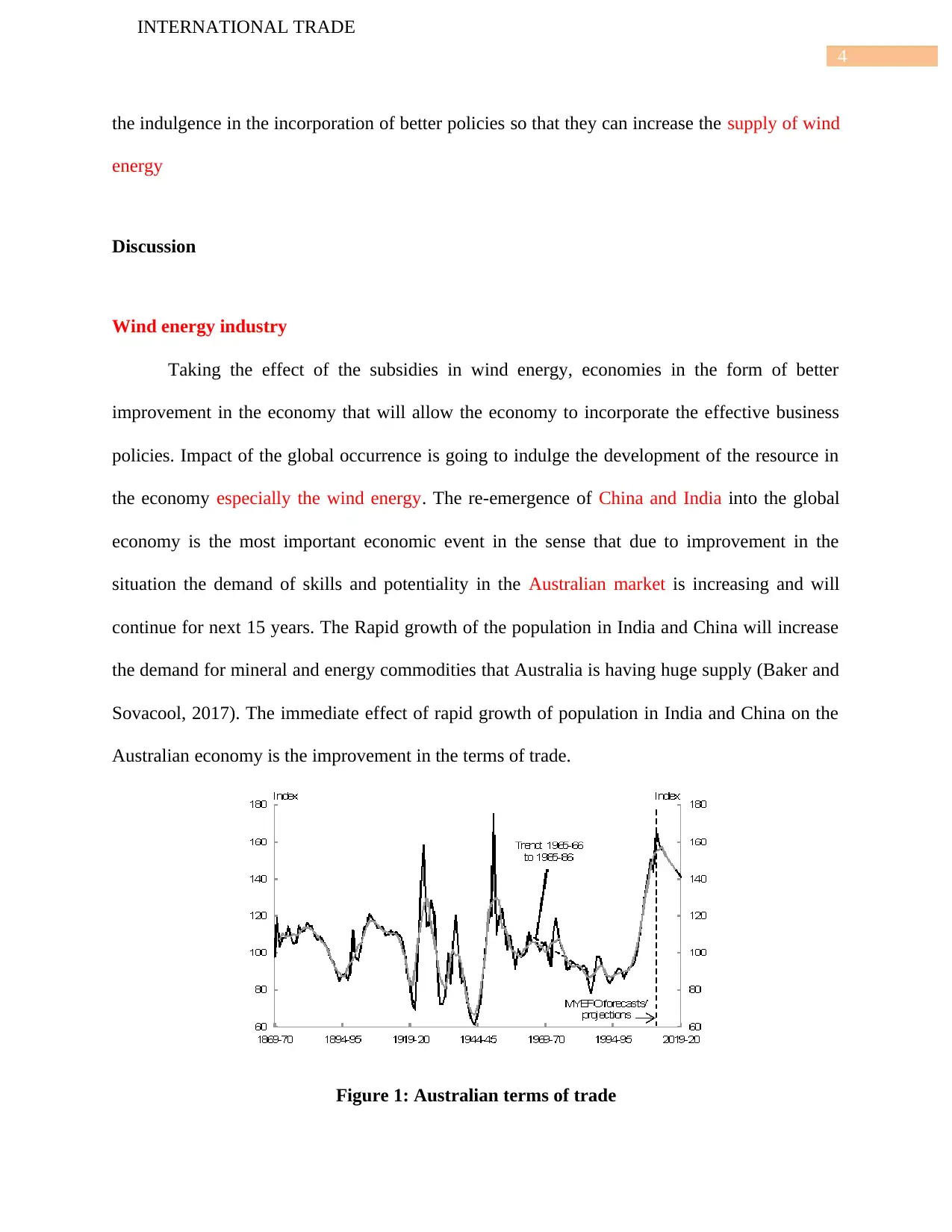
4
INTERNATIONAL TRADE
the indulgence in the incorporation of better policies so that they can increase the supply of wind
energy
Discussion
Wind energy industry
Taking the effect of the subsidies in wind energy, economies in the form of better
improvement in the economy that will allow the economy to incorporate the effective business
policies. Impact of the global occurrence is going to indulge the development of the resource in
the economy especially the wind energy. The re-emergence of China and India into the global
economy is the most important economic event in the sense that due to improvement in the
situation the demand of skills and potentiality in the Australian market is increasing and will
continue for next 15 years. The Rapid growth of the population in India and China will increase
the demand for mineral and energy commodities that Australia is having huge supply (Baker and
Sovacool, 2017). The immediate effect of rapid growth of population in India and China on the
Australian economy is the improvement in the terms of trade.
Figure 1: Australian terms of trade
INTERNATIONAL TRADE
the indulgence in the incorporation of better policies so that they can increase the supply of wind
energy
Discussion
Wind energy industry
Taking the effect of the subsidies in wind energy, economies in the form of better
improvement in the economy that will allow the economy to incorporate the effective business
policies. Impact of the global occurrence is going to indulge the development of the resource in
the economy especially the wind energy. The re-emergence of China and India into the global
economy is the most important economic event in the sense that due to improvement in the
situation the demand of skills and potentiality in the Australian market is increasing and will
continue for next 15 years. The Rapid growth of the population in India and China will increase
the demand for mineral and energy commodities that Australia is having huge supply (Baker and
Sovacool, 2017). The immediate effect of rapid growth of population in India and China on the
Australian economy is the improvement in the terms of trade.
Figure 1: Australian terms of trade
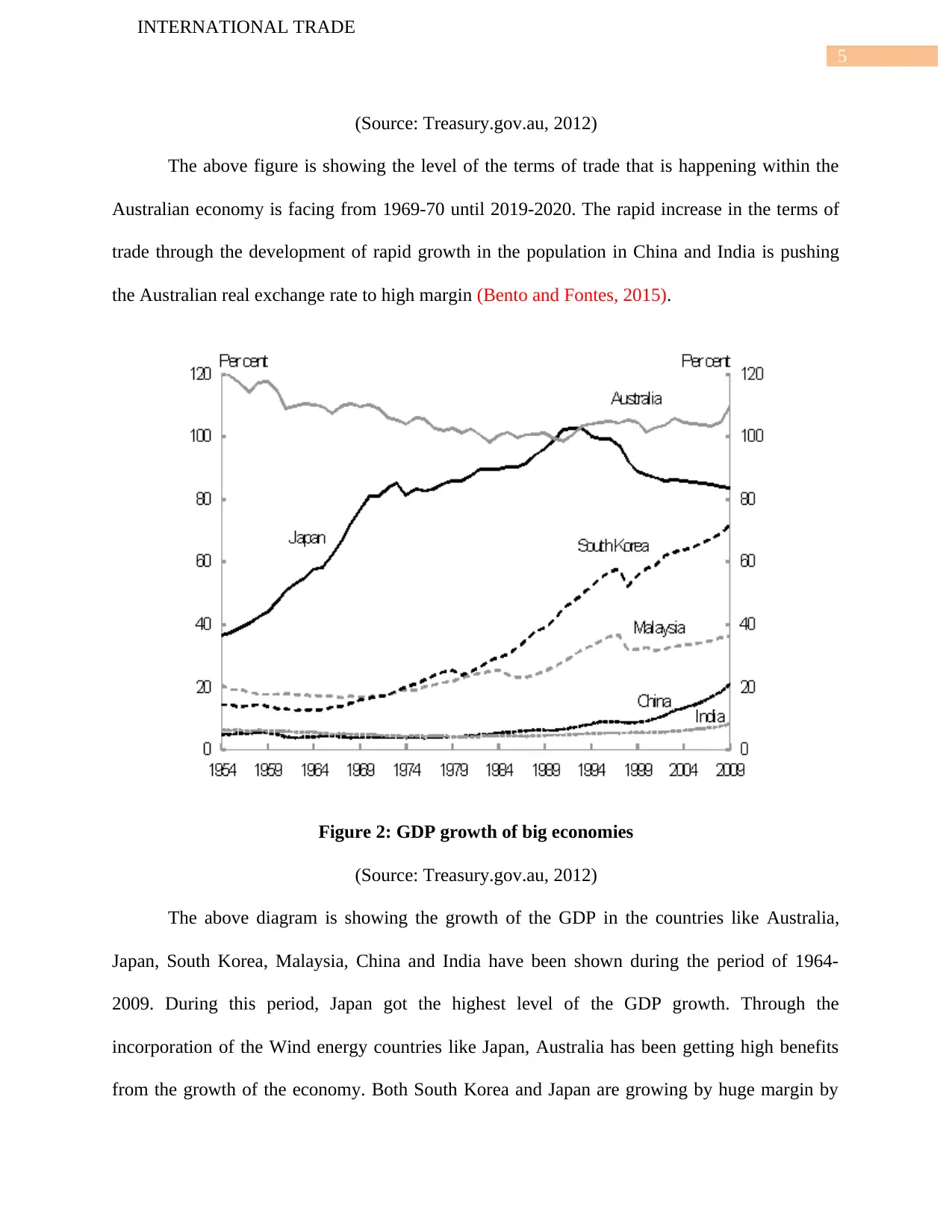
5
INTERNATIONAL TRADE
(Source: Treasury.gov.au, 2012)
The above figure is showing the level of the terms of trade that is happening within the
Australian economy is facing from 1969-70 until 2019-2020. The rapid increase in the terms of
trade through the development of rapid growth in the population in China and India is pushing
the Australian real exchange rate to high margin (Bento and Fontes, 2015).
Figure 2: GDP growth of big economies
(Source: Treasury.gov.au, 2012)
The above diagram is showing the growth of the GDP in the countries like Australia,
Japan, South Korea, Malaysia, China and India have been shown during the period of 1964-
2009. During this period, Japan got the highest level of the GDP growth. Through the
incorporation of the Wind energy countries like Japan, Australia has been getting high benefits
from the growth of the economy. Both South Korea and Japan are growing by huge margin by
INTERNATIONAL TRADE
(Source: Treasury.gov.au, 2012)
The above figure is showing the level of the terms of trade that is happening within the
Australian economy is facing from 1969-70 until 2019-2020. The rapid increase in the terms of
trade through the development of rapid growth in the population in China and India is pushing
the Australian real exchange rate to high margin (Bento and Fontes, 2015).
Figure 2: GDP growth of big economies
(Source: Treasury.gov.au, 2012)
The above diagram is showing the growth of the GDP in the countries like Australia,
Japan, South Korea, Malaysia, China and India have been shown during the period of 1964-
2009. During this period, Japan got the highest level of the GDP growth. Through the
incorporation of the Wind energy countries like Japan, Australia has been getting high benefits
from the growth of the economy. Both South Korea and Japan are growing by huge margin by
⊘ This is a preview!⊘
Do you want full access?
Subscribe today to unlock all pages.

Trusted by 1+ million students worldwide
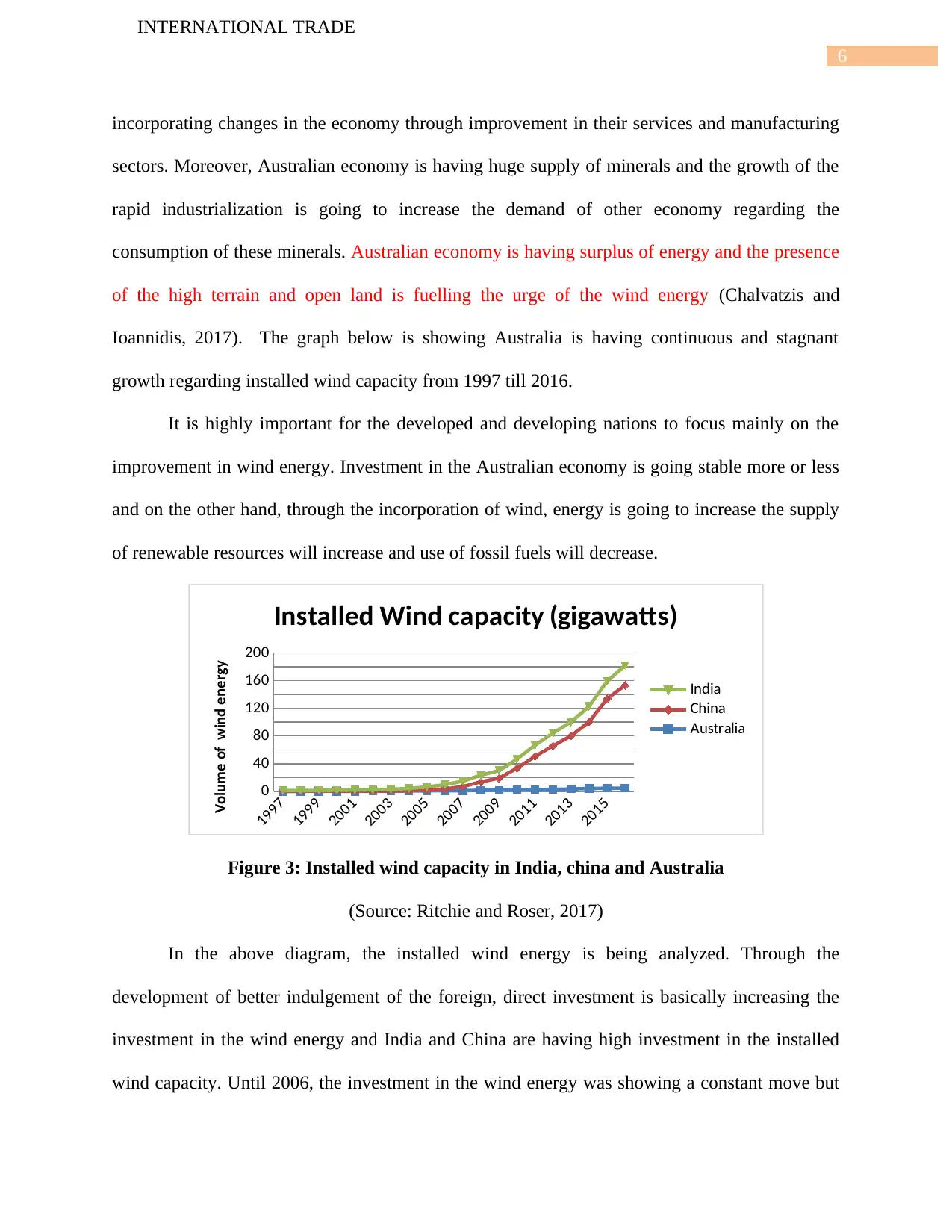
6
INTERNATIONAL TRADE
incorporating changes in the economy through improvement in their services and manufacturing
sectors. Moreover, Australian economy is having huge supply of minerals and the growth of the
rapid industrialization is going to increase the demand of other economy regarding the
consumption of these minerals. Australian economy is having surplus of energy and the presence
of the high terrain and open land is fuelling the urge of the wind energy (Chalvatzis and
Ioannidis, 2017). The graph below is showing Australia is having continuous and stagnant
growth regarding installed wind capacity from 1997 till 2016.
It is highly important for the developed and developing nations to focus mainly on the
improvement in wind energy. Investment in the Australian economy is going stable more or less
and on the other hand, through the incorporation of wind, energy is going to increase the supply
of renewable resources will increase and use of fossil fuels will decrease.
1997
1999
2001
2003
2005
2007
2009
2011
2013
2015
0
40
80
120
160
200
Installed Wind capacity (gigawatts)
India
China
Australia
Volume of wind energy
Figure 3: Installed wind capacity in India, china and Australia
(Source: Ritchie and Roser, 2017)
In the above diagram, the installed wind energy is being analyzed. Through the
development of better indulgement of the foreign, direct investment is basically increasing the
investment in the wind energy and India and China are having high investment in the installed
wind capacity. Until 2006, the investment in the wind energy was showing a constant move but
INTERNATIONAL TRADE
incorporating changes in the economy through improvement in their services and manufacturing
sectors. Moreover, Australian economy is having huge supply of minerals and the growth of the
rapid industrialization is going to increase the demand of other economy regarding the
consumption of these minerals. Australian economy is having surplus of energy and the presence
of the high terrain and open land is fuelling the urge of the wind energy (Chalvatzis and
Ioannidis, 2017). The graph below is showing Australia is having continuous and stagnant
growth regarding installed wind capacity from 1997 till 2016.
It is highly important for the developed and developing nations to focus mainly on the
improvement in wind energy. Investment in the Australian economy is going stable more or less
and on the other hand, through the incorporation of wind, energy is going to increase the supply
of renewable resources will increase and use of fossil fuels will decrease.
1997
1999
2001
2003
2005
2007
2009
2011
2013
2015
0
40
80
120
160
200
Installed Wind capacity (gigawatts)
India
China
Australia
Volume of wind energy
Figure 3: Installed wind capacity in India, china and Australia
(Source: Ritchie and Roser, 2017)
In the above diagram, the installed wind energy is being analyzed. Through the
development of better indulgement of the foreign, direct investment is basically increasing the
investment in the wind energy and India and China are having high investment in the installed
wind capacity. Until 2006, the investment in the wind energy was showing a constant move but
Paraphrase This Document
Need a fresh take? Get an instant paraphrase of this document with our AI Paraphraser
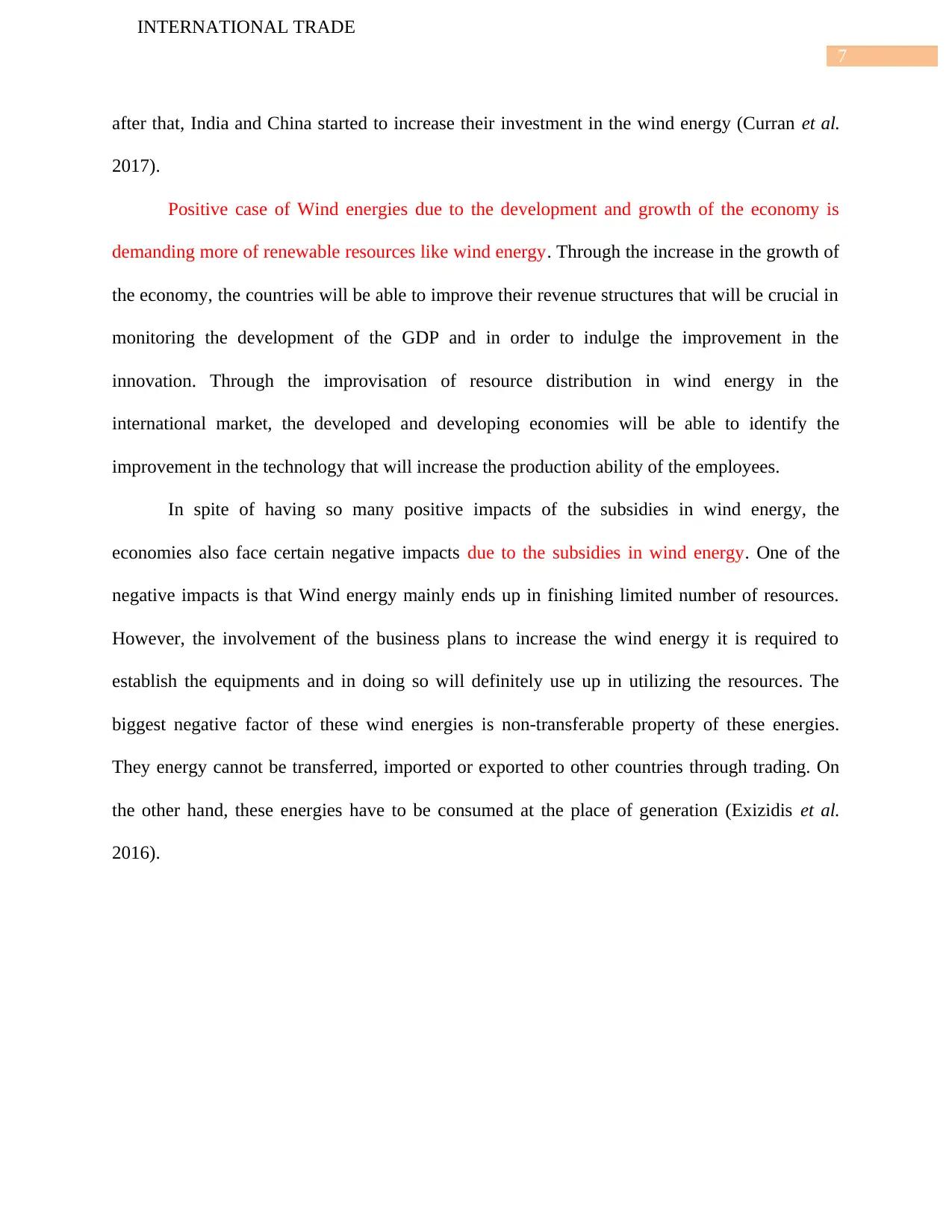
7
INTERNATIONAL TRADE
after that, India and China started to increase their investment in the wind energy (Curran et al.
2017).
Positive case of Wind energies due to the development and growth of the economy is
demanding more of renewable resources like wind energy. Through the increase in the growth of
the economy, the countries will be able to improve their revenue structures that will be crucial in
monitoring the development of the GDP and in order to indulge the improvement in the
innovation. Through the improvisation of resource distribution in wind energy in the
international market, the developed and developing economies will be able to identify the
improvement in the technology that will increase the production ability of the employees.
In spite of having so many positive impacts of the subsidies in wind energy, the
economies also face certain negative impacts due to the subsidies in wind energy. One of the
negative impacts is that Wind energy mainly ends up in finishing limited number of resources.
However, the involvement of the business plans to increase the wind energy it is required to
establish the equipments and in doing so will definitely use up in utilizing the resources. The
biggest negative factor of these wind energies is non-transferable property of these energies.
They energy cannot be transferred, imported or exported to other countries through trading. On
the other hand, these energies have to be consumed at the place of generation (Exizidis et al.
2016).
INTERNATIONAL TRADE
after that, India and China started to increase their investment in the wind energy (Curran et al.
2017).
Positive case of Wind energies due to the development and growth of the economy is
demanding more of renewable resources like wind energy. Through the increase in the growth of
the economy, the countries will be able to improve their revenue structures that will be crucial in
monitoring the development of the GDP and in order to indulge the improvement in the
innovation. Through the improvisation of resource distribution in wind energy in the
international market, the developed and developing economies will be able to identify the
improvement in the technology that will increase the production ability of the employees.
In spite of having so many positive impacts of the subsidies in wind energy, the
economies also face certain negative impacts due to the subsidies in wind energy. One of the
negative impacts is that Wind energy mainly ends up in finishing limited number of resources.
However, the involvement of the business plans to increase the wind energy it is required to
establish the equipments and in doing so will definitely use up in utilizing the resources. The
biggest negative factor of these wind energies is non-transferable property of these energies.
They energy cannot be transferred, imported or exported to other countries through trading. On
the other hand, these energies have to be consumed at the place of generation (Exizidis et al.
2016).
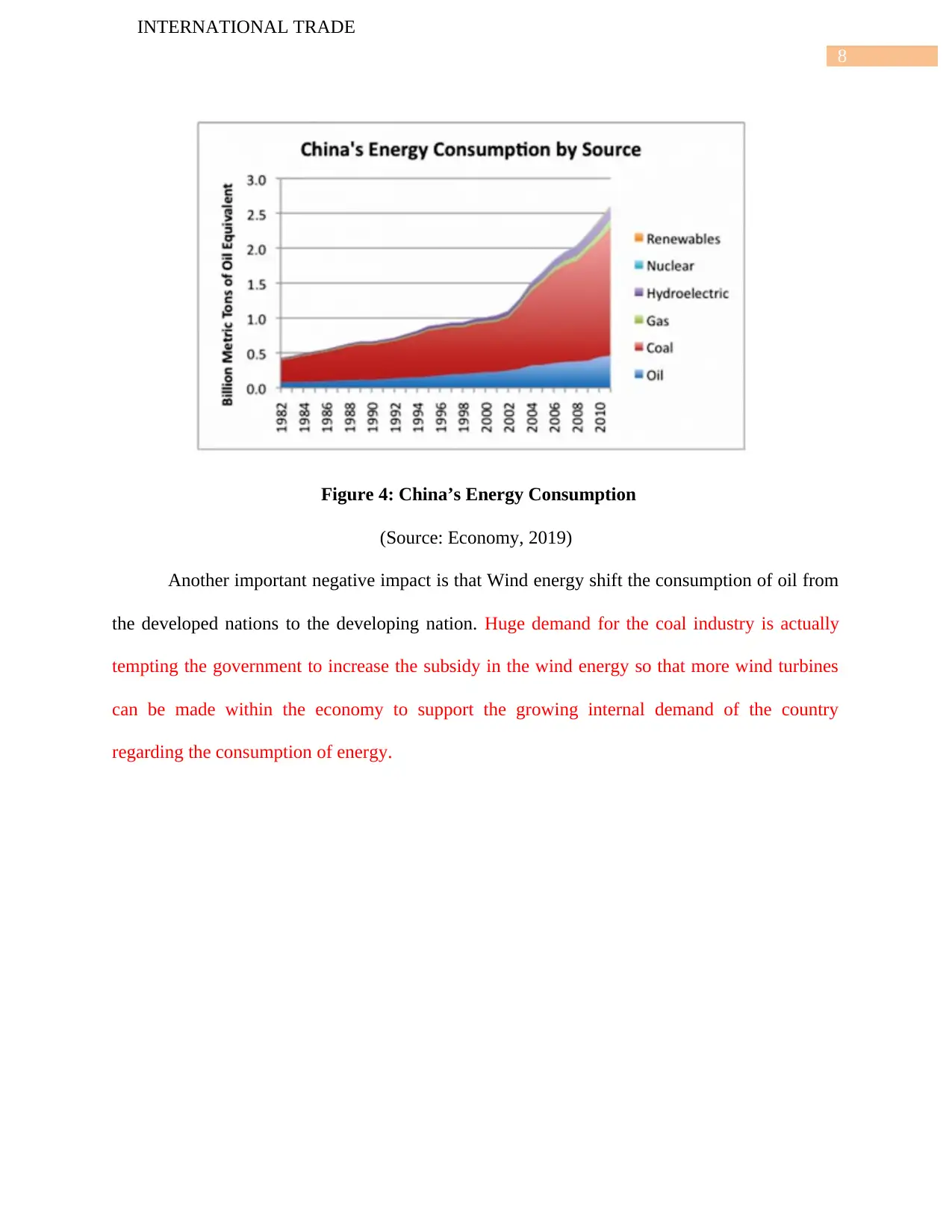
8
INTERNATIONAL TRADE
Figure 4: China’s Energy Consumption
(Source: Economy, 2019)
Another important negative impact is that Wind energy shift the consumption of oil from
the developed nations to the developing nation. Huge demand for the coal industry is actually
tempting the government to increase the subsidy in the wind energy so that more wind turbines
can be made within the economy to support the growing internal demand of the country
regarding the consumption of energy.
INTERNATIONAL TRADE
Figure 4: China’s Energy Consumption
(Source: Economy, 2019)
Another important negative impact is that Wind energy shift the consumption of oil from
the developed nations to the developing nation. Huge demand for the coal industry is actually
tempting the government to increase the subsidy in the wind energy so that more wind turbines
can be made within the economy to support the growing internal demand of the country
regarding the consumption of energy.
⊘ This is a preview!⊘
Do you want full access?
Subscribe today to unlock all pages.

Trusted by 1+ million students worldwide
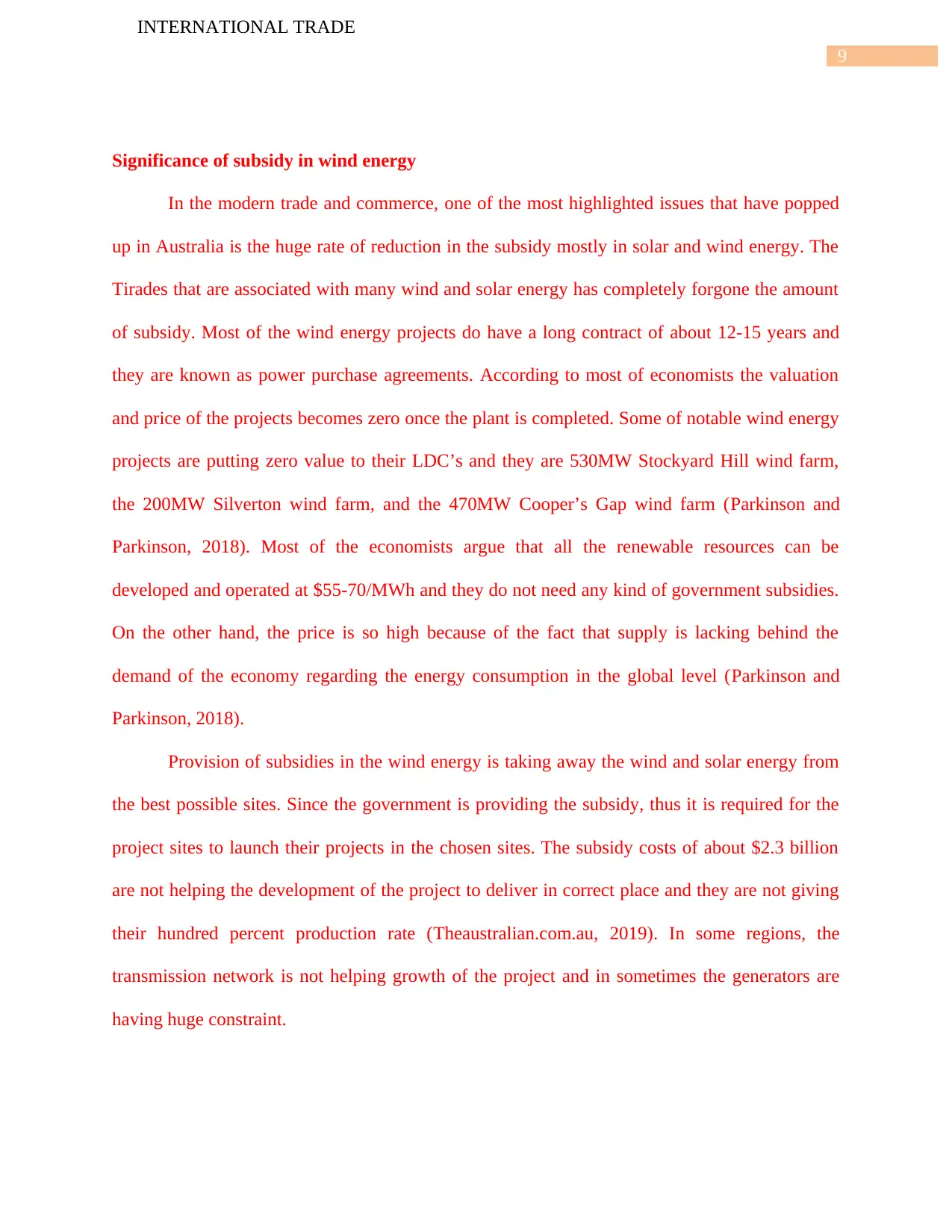
9
INTERNATIONAL TRADE
Significance of subsidy in wind energy
In the modern trade and commerce, one of the most highlighted issues that have popped
up in Australia is the huge rate of reduction in the subsidy mostly in solar and wind energy. The
Tirades that are associated with many wind and solar energy has completely forgone the amount
of subsidy. Most of the wind energy projects do have a long contract of about 12-15 years and
they are known as power purchase agreements. According to most of economists the valuation
and price of the projects becomes zero once the plant is completed. Some of notable wind energy
projects are putting zero value to their LDC’s and they are 530MW Stockyard Hill wind farm,
the 200MW Silverton wind farm, and the 470MW Cooper’s Gap wind farm (Parkinson and
Parkinson, 2018). Most of the economists argue that all the renewable resources can be
developed and operated at $55-70/MWh and they do not need any kind of government subsidies.
On the other hand, the price is so high because of the fact that supply is lacking behind the
demand of the economy regarding the energy consumption in the global level (Parkinson and
Parkinson, 2018).
Provision of subsidies in the wind energy is taking away the wind and solar energy from
the best possible sites. Since the government is providing the subsidy, thus it is required for the
project sites to launch their projects in the chosen sites. The subsidy costs of about $2.3 billion
are not helping the development of the project to deliver in correct place and they are not giving
their hundred percent production rate (Theaustralian.com.au, 2019). In some regions, the
transmission network is not helping growth of the project and in sometimes the generators are
having huge constraint.
INTERNATIONAL TRADE
Significance of subsidy in wind energy
In the modern trade and commerce, one of the most highlighted issues that have popped
up in Australia is the huge rate of reduction in the subsidy mostly in solar and wind energy. The
Tirades that are associated with many wind and solar energy has completely forgone the amount
of subsidy. Most of the wind energy projects do have a long contract of about 12-15 years and
they are known as power purchase agreements. According to most of economists the valuation
and price of the projects becomes zero once the plant is completed. Some of notable wind energy
projects are putting zero value to their LDC’s and they are 530MW Stockyard Hill wind farm,
the 200MW Silverton wind farm, and the 470MW Cooper’s Gap wind farm (Parkinson and
Parkinson, 2018). Most of the economists argue that all the renewable resources can be
developed and operated at $55-70/MWh and they do not need any kind of government subsidies.
On the other hand, the price is so high because of the fact that supply is lacking behind the
demand of the economy regarding the energy consumption in the global level (Parkinson and
Parkinson, 2018).
Provision of subsidies in the wind energy is taking away the wind and solar energy from
the best possible sites. Since the government is providing the subsidy, thus it is required for the
project sites to launch their projects in the chosen sites. The subsidy costs of about $2.3 billion
are not helping the development of the project to deliver in correct place and they are not giving
their hundred percent production rate (Theaustralian.com.au, 2019). In some regions, the
transmission network is not helping growth of the project and in sometimes the generators are
having huge constraint.
Paraphrase This Document
Need a fresh take? Get an instant paraphrase of this document with our AI Paraphraser
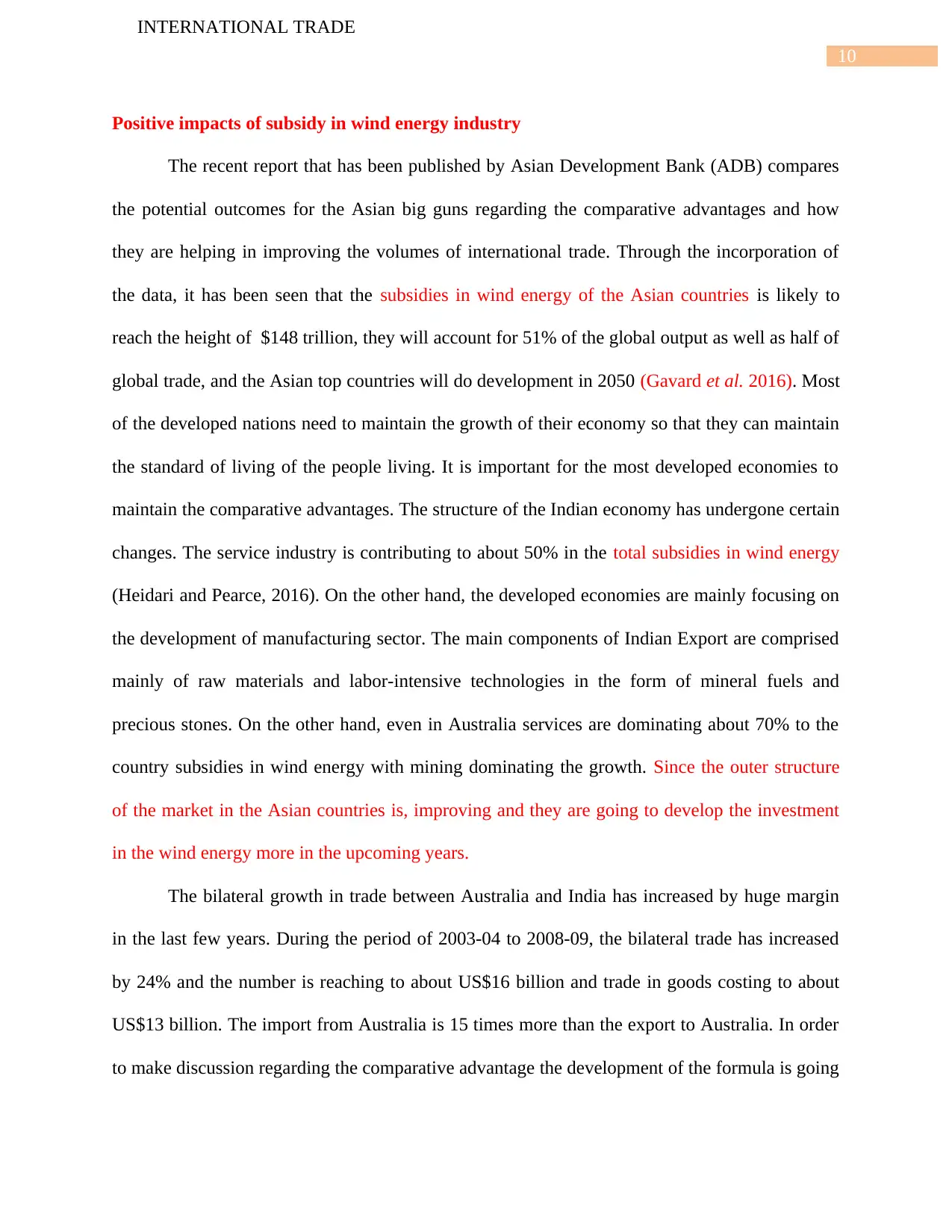
10
INTERNATIONAL TRADE
Positive impacts of subsidy in wind energy industry
The recent report that has been published by Asian Development Bank (ADB) compares
the potential outcomes for the Asian big guns regarding the comparative advantages and how
they are helping in improving the volumes of international trade. Through the incorporation of
the data, it has been seen that the subsidies in wind energy of the Asian countries is likely to
reach the height of $148 trillion, they will account for 51% of the global output as well as half of
global trade, and the Asian top countries will do development in 2050 (Gavard et al. 2016). Most
of the developed nations need to maintain the growth of their economy so that they can maintain
the standard of living of the people living. It is important for the most developed economies to
maintain the comparative advantages. The structure of the Indian economy has undergone certain
changes. The service industry is contributing to about 50% in the total subsidies in wind energy
(Heidari and Pearce, 2016). On the other hand, the developed economies are mainly focusing on
the development of manufacturing sector. The main components of Indian Export are comprised
mainly of raw materials and labor-intensive technologies in the form of mineral fuels and
precious stones. On the other hand, even in Australia services are dominating about 70% to the
country subsidies in wind energy with mining dominating the growth. Since the outer structure
of the market in the Asian countries is, improving and they are going to develop the investment
in the wind energy more in the upcoming years.
The bilateral growth in trade between Australia and India has increased by huge margin
in the last few years. During the period of 2003-04 to 2008-09, the bilateral trade has increased
by 24% and the number is reaching to about US$16 billion and trade in goods costing to about
US$13 billion. The import from Australia is 15 times more than the export to Australia. In order
to make discussion regarding the comparative advantage the development of the formula is going
INTERNATIONAL TRADE
Positive impacts of subsidy in wind energy industry
The recent report that has been published by Asian Development Bank (ADB) compares
the potential outcomes for the Asian big guns regarding the comparative advantages and how
they are helping in improving the volumes of international trade. Through the incorporation of
the data, it has been seen that the subsidies in wind energy of the Asian countries is likely to
reach the height of $148 trillion, they will account for 51% of the global output as well as half of
global trade, and the Asian top countries will do development in 2050 (Gavard et al. 2016). Most
of the developed nations need to maintain the growth of their economy so that they can maintain
the standard of living of the people living. It is important for the most developed economies to
maintain the comparative advantages. The structure of the Indian economy has undergone certain
changes. The service industry is contributing to about 50% in the total subsidies in wind energy
(Heidari and Pearce, 2016). On the other hand, the developed economies are mainly focusing on
the development of manufacturing sector. The main components of Indian Export are comprised
mainly of raw materials and labor-intensive technologies in the form of mineral fuels and
precious stones. On the other hand, even in Australia services are dominating about 70% to the
country subsidies in wind energy with mining dominating the growth. Since the outer structure
of the market in the Asian countries is, improving and they are going to develop the investment
in the wind energy more in the upcoming years.
The bilateral growth in trade between Australia and India has increased by huge margin
in the last few years. During the period of 2003-04 to 2008-09, the bilateral trade has increased
by 24% and the number is reaching to about US$16 billion and trade in goods costing to about
US$13 billion. The import from Australia is 15 times more than the export to Australia. In order
to make discussion regarding the comparative advantage the development of the formula is going
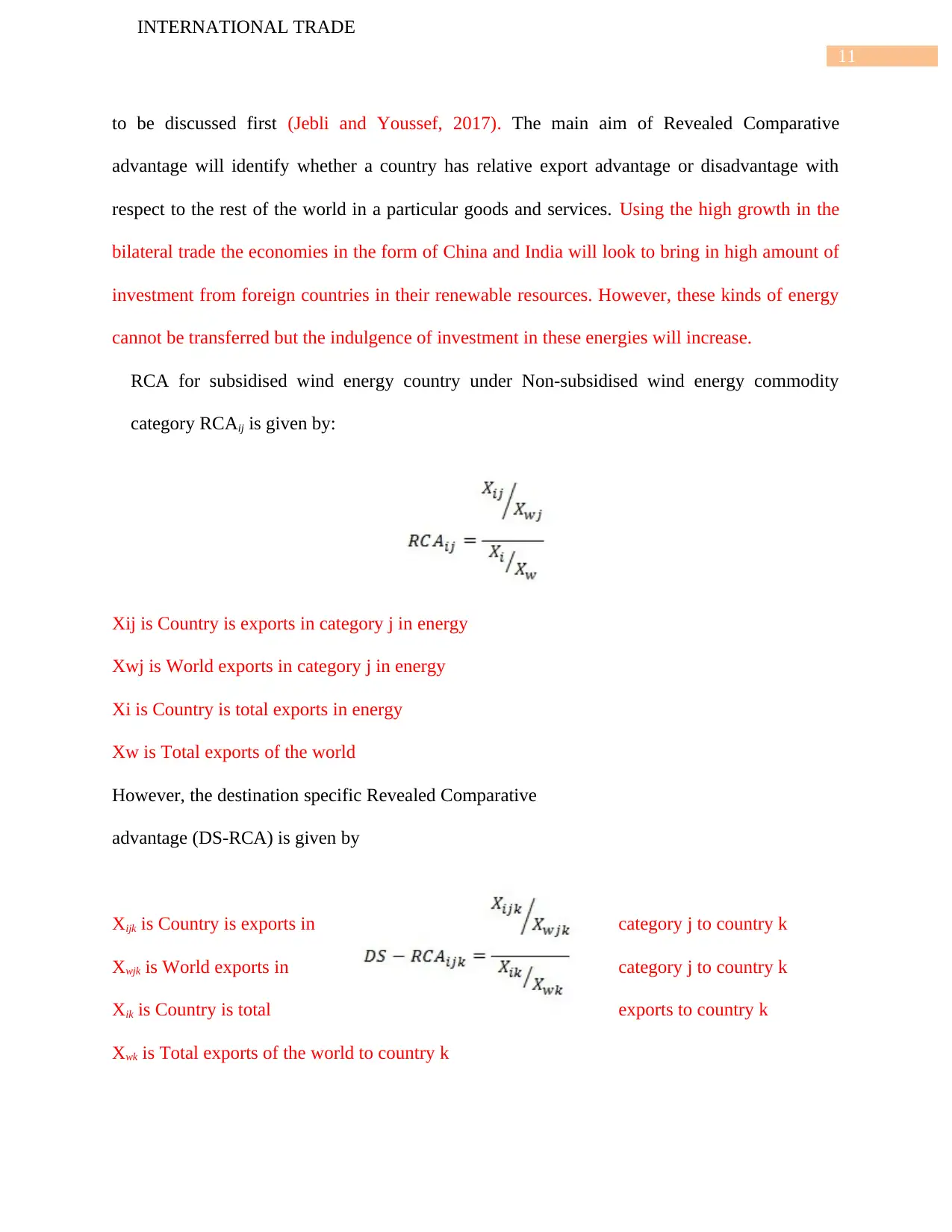
11
INTERNATIONAL TRADE
to be discussed first (Jebli and Youssef, 2017). The main aim of Revealed Comparative
advantage will identify whether a country has relative export advantage or disadvantage with
respect to the rest of the world in a particular goods and services. Using the high growth in the
bilateral trade the economies in the form of China and India will look to bring in high amount of
investment from foreign countries in their renewable resources. However, these kinds of energy
cannot be transferred but the indulgence of investment in these energies will increase.
RCA for subsidised wind energy country under Non-subsidised wind energy commodity
category RCAij is given by:
Xij is Country is exports in category j in energy
Xwj is World exports in category j in energy
Xi is Country is total exports in energy
Xw is Total exports of the world
However, the destination specific Revealed Comparative
advantage (DS-RCA) is given by
Xijk is Country is exports in category j to country k
Xwjk is World exports in category j to country k
Xik is Country is total exports to country k
Xwk is Total exports of the world to country k
INTERNATIONAL TRADE
to be discussed first (Jebli and Youssef, 2017). The main aim of Revealed Comparative
advantage will identify whether a country has relative export advantage or disadvantage with
respect to the rest of the world in a particular goods and services. Using the high growth in the
bilateral trade the economies in the form of China and India will look to bring in high amount of
investment from foreign countries in their renewable resources. However, these kinds of energy
cannot be transferred but the indulgence of investment in these energies will increase.
RCA for subsidised wind energy country under Non-subsidised wind energy commodity
category RCAij is given by:
Xij is Country is exports in category j in energy
Xwj is World exports in category j in energy
Xi is Country is total exports in energy
Xw is Total exports of the world
However, the destination specific Revealed Comparative
advantage (DS-RCA) is given by
Xijk is Country is exports in category j to country k
Xwjk is World exports in category j to country k
Xik is Country is total exports to country k
Xwk is Total exports of the world to country k
⊘ This is a preview!⊘
Do you want full access?
Subscribe today to unlock all pages.

Trusted by 1+ million students worldwide
1 out of 21
Related Documents
Your All-in-One AI-Powered Toolkit for Academic Success.
+13062052269
info@desklib.com
Available 24*7 on WhatsApp / Email
![[object Object]](/_next/static/media/star-bottom.7253800d.svg)
Unlock your academic potential
Copyright © 2020–2025 A2Z Services. All Rights Reserved. Developed and managed by ZUCOL.





